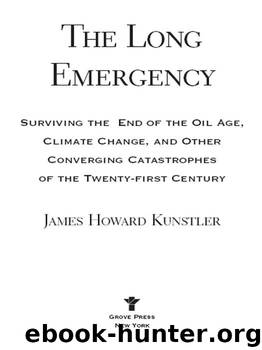The Long Emergency by James Howard Kunstlers

Author:James Howard Kunstlers [Kunstlers, James Howard]
Language: eng
Format: epub
Published: 2011-02-06T19:55:09+00:00
Environmental Destruction
The damage to global ecologies by human activity accelerated rapidly with the onset of industrialism. The twentieth century, with its oil-nurtured bloom of human population, was especially harsh. Everywhere, biological complexity was compromised or reduced to monoculture. Habitats were wrecked. Species were exterminated. Terrain and water were poisoned. The amount of asphalt paving alone in the United States represents an ecological insult beyond calculation. These man-made environmental catastrophes will combine with and be reinforced by the new problems of climate change in the Long Emergency.
Among the more melodramatic negative advertisements for what’s coming is the news that sea levels are rising and are likely to rise a lot more in this century. Places such as Bangladesh, the Netherlands, much of Florida, the Chesapeake Bay lowlands, New Orleans, and scores of Pacific islands could vanish underwater in the coming century. Harbor towns all over the world could be damaged or submerged. The worldwide ice meltdown is impressive. The Arctic has been warming dramatically and virtually all glaciers, ice caps, and ice sheets are melting. Sea ice is also retreating and thinning. The Alps have lost half of their glacial mass since 1850, with the loss accelerating during the past twenty years. Measurements by aircraft using global positioning satellites and laser altimeters show that the 5,000-square-kilometer Malaspina glacier in Alaska is losing nearly a meter of thickness per year—the equivalent of three cubic kilometers of water. Antarctic ice sheets are breaking up at an unprecedented rate. Between January and March 2002, two-thirds of the giant Larson B ice shelf collapsed, greatly altering the salinity of the surrounding seas and killing off plankton and krill that were the basis of the region’s wild food chain. The 700-foot-thick Larson had been in place for an estimated 12,000 years, and had lost 3,420 square miles since 1997 because of warming temperatures in the region. Only about 40 percent of the shelf remains. The Ross ice shelf, Antarctica’s largest at 332,000 square miles (about the size of France), may be next. Icebergs the size of Rhode Island and Manhattan are breaking off at a rate too great to be recorded. Generally, the temperature rise in the southern oceans has been greater than elsewhere around the globe.
According to the IPCC, sea levels rose by ten to twenty centimeters during the twentieth century, and are currently rising by about two millimeters a year, which is at the upper range of the rate of rise for the last century. With global warming accelerating, this is apt to increase. The generally accepted prediction is that sea levels will rise during the twenty-first century by about fifty centimeters, or a little under two feet, though some scientists predict a full meter. Roughly one-sixth of the people in the world live in coastal zones within one meter of sea level.
This is the kind of outside context problem so alien to contemporary experience that the public and its leaders can really find no way to process the information and figure out what to do about it—and for the excellent reason that it is not a problem with a direct solution.
Download
This site does not store any files on its server. We only index and link to content provided by other sites. Please contact the content providers to delete copyright contents if any and email us, we'll remove relevant links or contents immediately.
| Anthropology | Archaeology |
| Philosophy | Politics & Government |
| Social Sciences | Sociology |
| Women's Studies |
The Secret History by Donna Tartt(18951)
The Social Justice Warrior Handbook by Lisa De Pasquale(12170)
Thirteen Reasons Why by Jay Asher(8848)
This Is How You Lose Her by Junot Diaz(6836)
Weapons of Math Destruction by Cathy O'Neil(6220)
Zero to One by Peter Thiel(5736)
Beartown by Fredrik Backman(5682)
The Myth of the Strong Leader by Archie Brown(5461)
The Fire Next Time by James Baldwin(5386)
How Democracies Die by Steven Levitsky & Daniel Ziblatt(5175)
Promise Me, Dad by Joe Biden(5117)
Stone's Rules by Roger Stone(5053)
A Higher Loyalty: Truth, Lies, and Leadership by James Comey(4909)
100 Deadly Skills by Clint Emerson(4882)
Rise and Kill First by Ronen Bergman(4741)
Secrecy World by Jake Bernstein(4703)
The David Icke Guide to the Global Conspiracy (and how to end it) by David Icke(4658)
The Farm by Tom Rob Smith(4468)
The Doomsday Machine by Daniel Ellsberg(4452)
